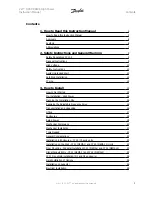
Page 24
©
2013 Magnum Energy, Inc
.
Installation
2.6.1
Equipment Grounding Conductors
The inverter case and all other noncurrent-carrying exposed metal surfaces in the entire electrical
system—that may be accidentally energized—must be grounded. The equipment-grounding conductor
must be sized to safely carry the maximum ground-fault current likely to be imposed on it from
where a ground-fault may occur. In accordance with the NEC, use Table 2-3 to size the equipment-
grounding conductors according to the rating of the overcurrent device protecting the circuit.
CAUTION:
The connections and wiring for the equipment-grounding conductor must be
continuous to allow fault currents to properly operate overcurrent devices. Whenever
equipment is removed that disconnects the bonding connection between the grounding
electrode conductor and the exposed conducting surfaces, a bonding jumper must be
installed while the equipment is being removed.
AC Side
– The AC equipment grounding conductor (EGC–AC) is sized per Table 2-3 and is connected
to the inverter’s AC equipment grounding terminal shown in Figure 2-8.
DC Side
– Since the currents on the DC side are much higher than the AC side, the equipment
grounding needs are different. The DC equipment grounding conductor (EGC–DC) is sized per Table
2-3 and connected to the DC equipment grounding terminal on the inverter as shown in Item 7,
Figure 1-2. For marine installations, the DC equipment grounding conductor (EGC-DC) is normally
required to be of an ampacity equal to that of the DC positive conductor (see Section 2.6.4).
Info
:
See Section 2.6.6 for information on connecting DC equipment grounding
conductors greater than #2 AWG (33.6 mm
2
).
Info
:
The equipment grounding conductors (EGC) and the grounding electrode
conductors (GEC) must be either insulated (green or green with a yellow stripe) or bare
copper. However, for conductors larger than #6 AWG (13.3 mm
2
) the exposed insulation
can be colored green, or covered with green tape or green adhesive labels.
Table 2-3, Equipment Grounding Conductor Sizing
Rating of
Overcurrent Device
Minimum Size of
Copper Ground Wire
Rating of
Overcurrent Device
Minimum Size of
Copper Ground Wire
20 amps
#12 AWG (3.3 mm
2
)
200 amps
#6 AWG (13.3 mm
2
)
30 - 60 amps
#10 AWG (5.3 mm
2
)
300 amps
#4 AWG (21.1 mm
2
)
100 amps
#8 AWG (8.4 mm
2
)
400 amps
#3 AWG (26.7 mm
2
)
2.6.2
Grounding Electrode Conductors
AC Side
– The size of the AC grounding electrode conductor (GEC–AC) depends on the size of the
largest ungrounded conductor feeding the AC load center. For ungrounded conductors that are #2
AWG (33.6 mm
2
) or smaller, use a minimum #8 AWG (8.4 mm
2
) copper conductor.
DC Side
– When the DC (GEC-DC) and AC (GEC-AC) grounding electrode conductors are connected
to a single grounding electrode, the size of the DC grounding electrode conductor cannot be smaller
than the largest conductor in the DC system (usually the battery-to-inverter cable).
2.6.3
System Bonding Jumpers
AC Side
– The AC system bonding jumper (SBJ) provides the neutral-to-ground “bond” between
the grounded conductor (AC neutral) and the equipment grounding conductor, and is required in
only one place in the AC electrical system. When the MSH-M is connected to an external AC source
(i.e., shorepower), the external AC source must provide the bond. However, when the external AC
source is disconnected and the inverter is providing the AC power (i.e., inverting), an internal relay
inside the inverter connects the neutral and ground to provide the bond. See Section 2.6.5 for more
information on the neutral-to-ground switching feature.
DC Side
– The size of the system bonding jumper (SBJ) in the DC electrical system must not be
smaller than the DC grounding electrode conductor (GEC–DC) used.
















































